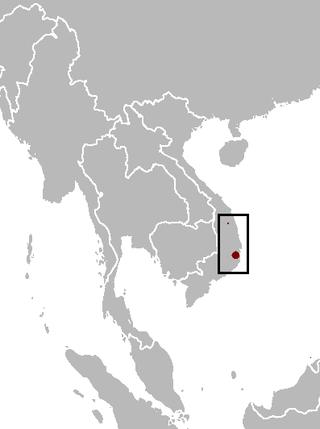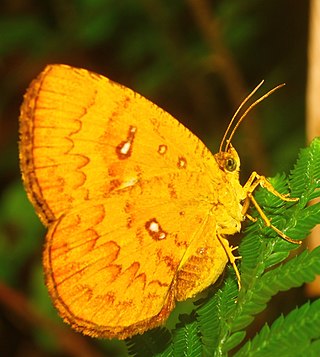
The green pheasant, also known as the Japanese green pheasant, is an omnivorous bird native to the Japanese archipelago, to which it is endemic. Some taxonomic authorities consider it a subspecies of the common pheasant, Phasianus colchicus. It is the national bird of Japan.

Tinea versicolor is a condition characterized by a skin eruption on the trunk and proximal extremities. The majority of tinea versicolor is caused by the fungus Malassezia globosa, although Malassezia furfur is responsible for a small number of cases. These yeasts are normally found on the human skin and become troublesome only under certain circumstances, such as a warm and humid environment, although the exact conditions that cause initiation of the disease process are poorly understood.

The silver teal or versicolor teal is a species of dabbling duck in the genus Spatula. It breeds in South America.

The Antilles pinktoe tarantula, also known as the Martinique red tree spider or the Martinique pinktoe, is popular as a pet spider because of its docile character and unique coloration.

Iris versicolor is also commonly known as the blue flag, harlequin blueflag, larger blue flag, northern blue flag, and poison flag, plus other variations of these names, and in Britain and Ireland as purple iris.

Trametes versicolor – also known as Coriolus versicolor and Polyporus versicolor – is a common polypore mushroom found throughout the world. Meaning 'of several colors', versicolor accurately describes this fungus that displays a unique blend of markings. Additionally, owing to its shape being similar to that of a wild turkey's tail feathers, T. versicolor is most commonly referred to as turkey tail. A similar-looking mushroom commonly called "false turkey tail" is from a different order (Stereum), and thus may sometimes be confused with the 'true' turkey tail mushroom, T. versicolor. Another lookalike is the multicolor gill polypore, T. betulina.

The gray treefrog is a species of small arboreal holarctic tree frog native to much of the eastern United States and southeastern Canada.

Friedrich Alexander Hermann Pagenstecher was a German ophthalmologist born in Wallau.

Panulirus versicolor is a species of spiny lobster that lives in tropical reefs in the Indo-Pacific. Other names include painted lobster, common rock lobster, bamboo lobster, blue lobster, and blue spiny lobster. P. versicolor is one of the three most common varieties of spiny lobster in Sri Lanka, alongside Panulirus homarus and Panulirus ornatus.

Arnold Andreas Friedrich Pagenstecher was a German doctor and entomologist. He was especially interested in Lepidoptera, especially Papilionidae. He wrote Die geographische Verbreitung der Schmetterlinge. Jena: Gustav Fischer 451 p. Maps (1909).

The Vietnam mouse-deer, also known as the silver-backed chevrotain, is an even-toed ungulate in the family Tragulidae known only from Vietnam. It was first described in 1910 by British zoologist Oldfield Thomas, who procured four specimens from Nha Trang in Annam. Little is known about its distribution and ecology. After 1910, the Vietnam mouse-deer was reported next in 1990 near Dak Rong and Buon Luoi in the Gia Lai Province. With increasing hunting pressure, habitat loss due to deforestation and no more reports of the species in the wild, the mouse-deer was feared to have gone extinct. The IUCN listed the species as Data Deficient in 2008. In 2019, a study confirmed the presence of the Vietnam mouse-deer in dry low-lying forests of southern Vietnam with camera trap evidence. The mouse-deer is characterised by a rough coat with a strange double-tone coloration unseen in other chevrotains; the front part of the body is reddish brown and contrasts strongly with the greyish posterior. It has big reddish brown ears, white and dark reddish brown marks on the throat.

Caprinia is a genus of moths of the family Crambidae.

Callidula is a genus of moths of the family Callidulidae.
Decliniidae is a family of beetles belonging to Scirtoidea. It contains the single genus Declinia with two species, D. relicta and D. versicolor, found in the Russian Far East and Japan, respectively. Little is known of their ecology, and their larvae are unknown. Specimens of D. relicta were found with pollen grains in their gut.

Caprinia castanealis is a species of moth of the family Crambidae. It is found in Papua New Guinea.

Caprinia unicoloralis is a species of moth of the family Crambidae. It was described by George Hamilton Kenrick in 1907 and it is found in Papua New Guinea.

Aspergillus versicolor is a slow-growing species of filamentous fungus commonly found in damp indoor environments and on food products. It has a characteristic musty odor associated with moldy homes and is a major producer of the hepatotoxic and carcinogenic mycotoxin sterigmatocystin. Like other Aspergillus species, A. versicolor is an eye, nose, and throat irritant.
Caprinia felderi is a moth in the family Crambidae. It was described by Julius Lederer in 1863. It is found in India (Assam), on Java and Ambon Island, as well as in Australia, where it has been recorded from Queensland.
Caprinia periusalis is a moth in the family Crambidae. It was described by Francis Walker in 1859. It is found in Venezuela.

Epomophorinae is a subfamily of megabat. It was established as a subfamily in 1997. Epomophorine bats are found only in Africa.
















